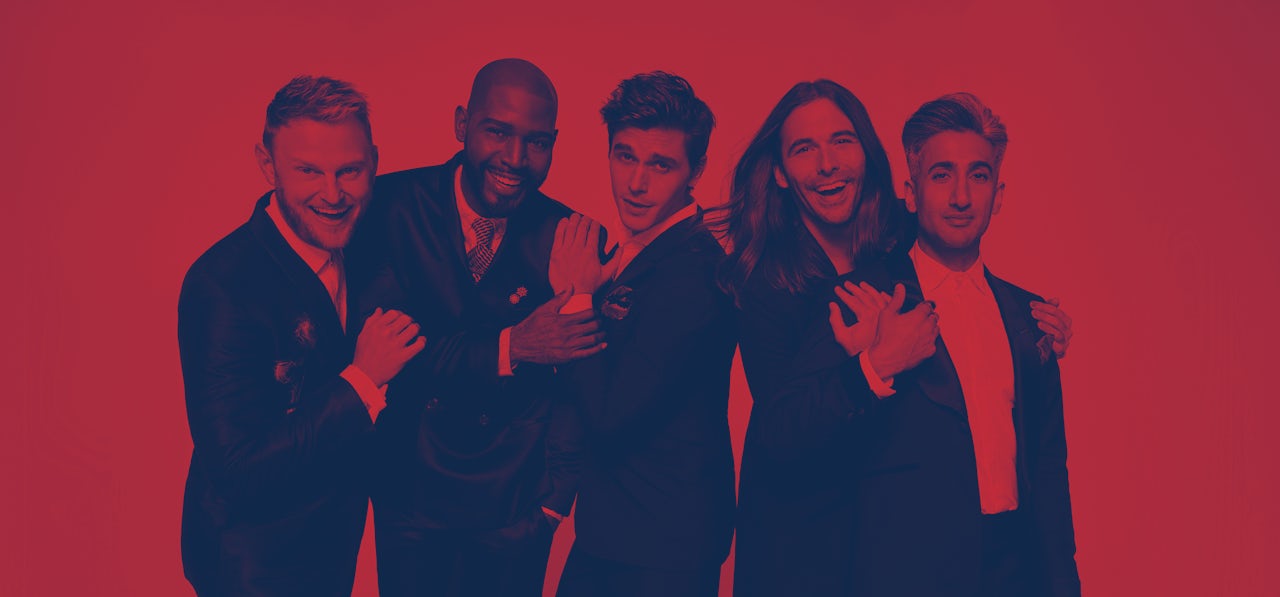Tomorrow, Netflix is bringing back a relic of an era when people still said “metrosexual” with a straight face. Queer Eye — formerly Queer Eye for the Straight Guy, which debuted in 2003 — is a show where gay men re-evaluate the fashion of their sad, straight male brethren. The reboot has been updated to star a new, younger, slightly more racially diverse Fab Five. Instead of New York City, the new crew is now based out of Atlanta, traveling around the surrounding area in search of new outfits to revamp. The change in location is obvious attempt to foster “wow, we’re not as different as we thought” story lines, as in one episode when the group makes over a police officer. The episode starts with an ill-conceived prank scene in which a different officer pulls the Fab Five over while Karamo Brown, the show's sole black man, is driving the car. The tension is only mildly cut when the officer announces the group will be making over his friend. In the most panderingly heartfelt moment of the season, near the episode's end, Brown and their straight guy get teary-eyed talking about the new understanding and closeness they've developed over the course of the makeover.
The original Queer Eye, called Queer Eye for the Straight Guy for the first two seasons, was an unexpected success when it premiered in 2003, and one of very few television shows focusing on out queer men. Its first season hit a viewership high of 3.34 million viewers, giving Bravo its then-biggest audience ever. Jay Leno and members of the Boston Red Sox appeared on it; the show was nominated for four Emmys and won the 2004 award for Outstanding Reality Program; overseas networks, including in Australia and the UK, released their own versions. Original members of the Fab Five have continued on to other showbiz opportunities: Chopped host Ted Allen started on Queer Eye, as did actor Jai Rodriguez and RuPaul’s Drag Race judge Carson Kressley.
The way that people are handling representation now with queerness... is they're just building it into broader stories.
In 2018, queer representation in television is much more diverse. Since the debut of Queer Eye, American television audiences have seen the launch of Ellen Degeneres’ talk show, the establishment of Logo TV in 2005, the premiere of Modern Family and RuPaul’s Drag Race in 2009, and a long, slow shifting of social norms, the most prominent being the nationwide legalization of gay marriage in 2015. Though it received its fair share of criticism for offering a narrow, stereotypical portrayal of gay men, Queer Eye was part of a large cultural shift on television. “Our little part was being visible and being ourselves and letting people get to know us… it takes the phobia away. And hopefully we did that.” Kressley said during a 2013 interview on the original show’s 10-year anniversary.
Today, the updated Queer Eye’s audience will likely be bound by nostalgia, rather than the sheer curiosity and novelty that animated its first iteration. It also debuts in a television space that no longer prioritizes delineating “gay” television from “straight” television. “The way that people are handling representation now with queerness or with respect to being gay or sexual identity is they're just building it into broader stories,” John M. Wolf, queer media scholar and Assistant Dean of the College of Science and Liberal Arts at the New Jersey Institute of Technology told The Outline. There are downsides to this generalist approach, Wolf said. “That doesn't mean that there isn't a need for space that is queer by design. That doesn't mean it can't be used and consumed or whatever by people who aren't queer. But but I think we don't want to forfeit that without a lot of consideration.”
Perhaps the biggest change the new Queer Eye faces is a more demanding audience and a larger, more influential sea of cultural critique. The original Queer Eye was critiqued for relying on stereotypes that gay men are more effusive, effeminate, and concerned with appearance than straight men, who can’t find their way around a comb. And though the new Fab Five includes married people, fathers, and more men of color (one member of the new Fab Five is black, another is South Asian, the rest appear white) echoes of the original problems critics latched onto — namely the show’s focus on the perspectives of mostly white, well-off, cisgender men — remain. “I don't think we want to discourage conversations about difference which of course is what the show is seeking to do,” Wolf said. “[But] was that show truly queer in terms of resisting the status quo, when it's gay men making over straight men in keeping with current trends or specific ideas about style, beauty, and traditional relationships? I'm not so sure.”
Forward progress in a commercial creative medium like television is hard to parse, as what counts as representation to one person contributes to erasure for another. There are few accepted standards for how American media can be better, or how quickly its evolution should be happening. The pure thirst for entertainment, whether it is politically agreeable or not, is the only constant — and really, Queer Eye can’t do much better than making good television that people want to watch. As new Fab Five member Antoni Porowski recently told Variety, “The universality of wanting to show up for yourself is the same. Helping people is never going to get old.�� Boldly queer or not, that’s a message most TV audiences can get with, and which might lead to another Queer Guy reboot in, say, 2033.
